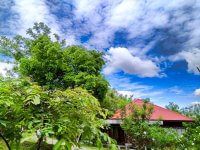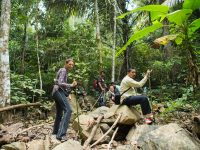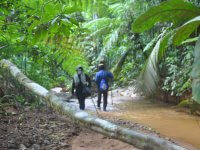Cambodia’s Khmer Rouge territory plays host to tourists at luxury resort

Swimming along the bottom of the saltwater pool at the Memoria Palace Luxury Resort Cambodia, I open my eyes and look at the neat blue-and-white tiles spread out before me, trying to square the pristine sight with what I’d heard a few hours earlier about the land beneath the water: It used to be chock-full of mines.
“One-hundred and twenty pieces!” owner Panhavuth Long had told me over a late-morning breakfast of coffee and fried noodles on my first morning at Memoria. He had bought the property several years ago from the local commune chief. After it was deemed safe for development, he opened Memoria in August.
Quoting the exact number of life-threatening objects that used to be in the ground was not out of character for Panhavuth Long. Like other Cambodians I’ve come to know since moving here in 2012, he seems to have filed away certain distances and dates in his memory, available for retrieval at a moment’s notice. He can cite the precise number of kilometers from Phnom Penh to Cambodia’s outlying provinces, figures drummed into him in school. It’s the same with history. One common way of referring to the Khmer Rouge regime, which took power in April 1975 and caused the deaths of at least 1.7 million Cambodians, is to cite how long it lasted: “three years, eight months and 20 days.” And so it is with the land mines — which, by the way, have been cleared.
The morning we chatted, Panhavuth Long explained in unusually honest detail the gamble inherent in trying to lure visitors to his resort. It’s set a six-hour drive northwest of Phnom Penh, in Pailin province, on Cambodia’s northwest border with Thailand. Pailin is slowly sloughing off its reputation as, well, take your pick — dusty, remote, war-torn, pitiful, malaria-ridden, regrettable, better left alone, etc. About 70 percent of the residents today are ex-Khmer Rouge fighters and commanders, Panhavuth Long said. The hill above the Memoria pool was once an artillery depot. Barrels of tanks once stretched out over what is now a line of sun chairs.
A stone-lined path connects 16 spacious bungalows situated around a small pond with a raised mound in the middle. Banana and frangipani trees and vegetable gardens bloom beside the stones. The resort is 20 minutes from the Thai border, where the northern end of the Cardamom Mountains peter out into green farmland, watersheds and a river where Cambodians look for precious gemstones. The region was once full of them. At the entrance to the center of Pailin town, authorities have constructed a fountain statue of an enormous red ruby.
The Khmer Rouge held on and battled it out in the local foothills before cutting a peace deal with the government in 1996. As part of the agreement, the government carved a territory for former regime members to live in out of a province next door. This is Pailin, which looks very weird on a map, like a patch applied to torn jeans. Some members of Phnom Penh’s younger generation think that Pailin is in Thailand, when they think of it at all. But the disconnect runs both ways. After eating breakfast, we visited an old swing bridge. Panhavuth Long asked a woman at the entrance where she’d bought the palm fruit assembled before her. “In Cambodia,” she replied, meaning not in Pailin.
So far, his resort is struggling and hasn’t made any profit, a fact that was oddly mentioned in the welcome book in my bungalow. Though he’s committed to hiring children of the defeated revolutionaries, he says that the lack of education — only recently did Pailin get a high school — and an upbringing in times of conflict means that the teens’ skills are limited to “farming, cutting trees and maybe fighting.” Panhavuth Long has had to bring in experienced service professionals to fill management positions. There are other, shall we say, “branding” problems. “Because Pailin is considered to be all Khmer Rouge, no one wants to come here,” he said. “Secondly, there are still land mine fields deep in the forest, and there is still malaria up in the jungle. If you go onto the Web and type in Pailin, no one recommends you to visit.”
The comment reminded me of what I’d read in a 2010 edition of “Lonely Planet Cambodia.” Pailin has little to recommend it, the entry on the province says, unless you’re an aging Khmer Rouge retiree seeking the company of your former brothers-in-arms.
But the area’s combination of history and natural beauty, with its waterfalls and wildlife and legacy of war, intrigued Panhavuth Long. He’s not a businessman by trade. In his day job, he’s a court monitor for an international nonprofit that keeps an eye on the Khmer Rouge tribunal, a U.N.-backed court set up to try the regime’s senior leaders. So far, only a prison director has been convicted. The current case is beset by funding problems and the poor health of the defendants, one of whom, Ieng Sary, escaped judgment in March when he died at 87. The former head of the Khmer Rouge air force, widely believed to be the target of a future case, died last month.
Nuon Chea, one of two defendants currently on trial, was arrested in Pailin in 2007. The sitting governor of the province worked for Pol Pot, the Khmer Rouge strongman. Next to the room where I stayed is a fruit farm that belongs to the family of Ieng Sary, who was minister of foreign affairs under the Khmer Rouge. Green jackfruit as big as footballs hang from the trees.
Panhavuth Long isn’t the only one who has an uncommon attachment to Pailin. Spend a few days there, and you’ll start to meet its boosters and regulars. At dinner on the second night, a regular at the resort introduced himself to me and a colleague as one of the leading dentists in Cambodia. He plied us with vodka and coconut juice, then told us about his business idea to process and export to Thailand one of Pailin’s famous fruits, the longan, a sweet, gelatinous pitted treat the size of a jumbo olive. We met a consultant to the governor who explained in a vague but “you just wait and see” tone that a tourism master plan was in the works.
But for now things are quiet, especially after the sun goes down, the pool closes and the treks end. On our last night, we traveled to the border and several dingy casinos where the game of choice was, for some reason, baccarat. Out of boredom, I walked across the apparently unmanned border checkpoint, waved from Thailand at my alarmed co-worker, and walked back.
The return ride to the resort took a while, because one of the motorbikes we were passengers on ran out of gas. The sky was pitch black; there were no roadside lights. I wondered whether I should be worried that we were in a place where most people probably know how to operate an automatic weapon. It was a stupid thought. I was more likely to die in a traffic accident than at the hands of someone who’d forgotten that the war was over.
The only sounds we heard were barking dogs. With no gas station for miles, the driver of my motorbike accelerated while I sat behind him holding the hand of the gasless bike’s driver. Momentum carried us toward town. Our only guides were the electronic displays of Khmer New Year shrines twinkling from roadside homes.
details
Memoria Palace & Resort
Pailin, Cambodia
011-855-15-430-014
www.memoriapalace.com
Standard rooms $45, deluxe rooms $85, suites $105.
Freeman is an editor at the Phnom Penh Post in Phnom Penh.
https://www.washingtonpost.com/lifestyle/travel/cambodias-khmer-rouge-territory-plays-host-to-tourists-at-luxury-resort/2013/07/03/ffe2bd00-deb0-11e2-963a-72d740e88c12_story.html




